How to properly grow walnuts at home
Walnuts are grown not only in the gardens of India and China, but also in Russian dachas. The trees are tall, stately, reaching a height of 20 m. For novice gardeners, growing a walnut tree seems like a difficult task. In this case, experienced summer residents advise first planting a seedling at home and only then moving it to the site. In this article we will look in detail at how to grow walnuts at home and what agricultural rules to follow.
How to grow a walnut seedling at home
Walnut seedlings are unpretentious in care. Healthy planting material is obtained from both nuts and cuttings.
Each method has its own characteristics and characteristics.
From walnut
The advantage of growing walnut seedlings is that such plants produce little root growth and quickly adapt to external conditions. Young walnuts retain the taste and commercial qualities of the parent tree and are distinguished by strong immunity.
Before planting, nuts are selected and prepared, as well as suitable soil and container.
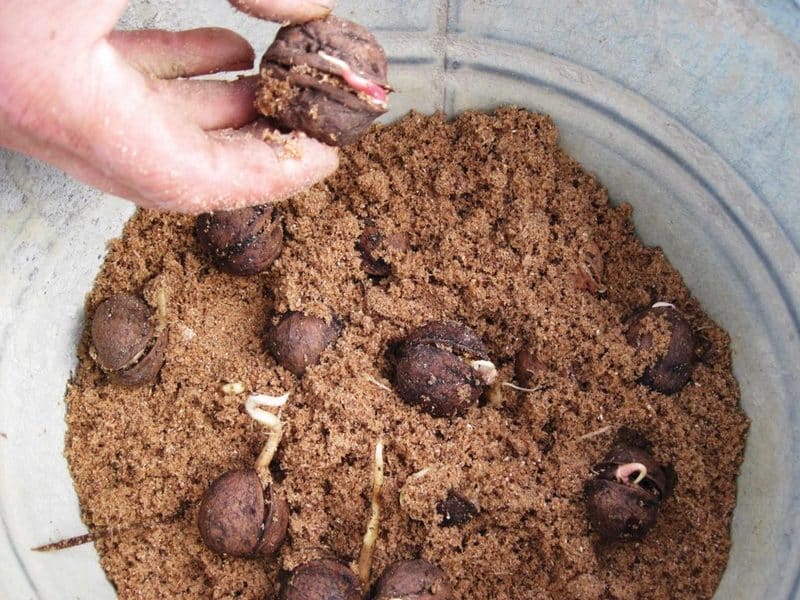
Selection and preparation of planting material
Hard walnuts are chosen for planting at home. They are tasted - they should not be bitter. To be sure, it is recommended to eat several fruits from one tree at once to make sure that they all taste good.
Pay attention to the appearance of the fruit: there should be no traces of diseases, insects or other damage.Cracks, breaks and mold are also unacceptable.
Attention! The weight of a suitable fruit is felt in the hand. If it is light, it means the nut is empty, and it will not be possible to grow a fruitful tree from it.
For planting, choose fresh nuts, not last year's ones. They are placed in a deep plate and filled with warm water with potassium permanganate. The nuts that have sunk to the bottom are used later. They are left to soak for 3-4 hours - during this time they are disinfected and slightly opened. This procedure stimulates the sprout to peck.
Preparing the soil and container
For walnuts, prepare a deep container: a basin, a pan, a tub with drainage holes. The diameter of the container must be at least 30 cm, then the plant is transplanted into a new pot with a diameter of 40-45 cm. The container is washed with clean water and wiped dry with a towel. Next, they are disinfected and treated with a solution of potassium permanganate.
The soil chosen is loose and well-permeable to air. A mixture of purchased and garden soil is suitable - they are mixed in equal parts and peat or humus is added. If the soil is clayey, it is improved by adding compost. The drainage layer consists of vermiculite, expanded clay, broken brick or small crushed stone. The recommended soil acidity level is 5.5-5.8 pH.
From a cutting
Cuttings are a vegetative method of propagation. If all planting rules are followed, the walnut tree produces a harvest within 3-4 years. Gardeners use both green and woody cuttings.
Selection and preparation of planting material
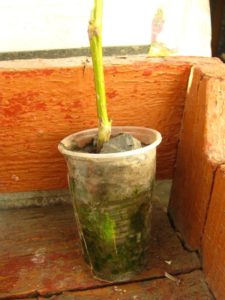
For planting, choose cuttings no older than 3 years. These must be healthy and elastic shoots without defects or damage. The diameter of the stem should not exceed 1.5 cm.
Gardeners cut branches 35-40 cm long from the mother tree.Cuttings are harvested in summer or spring, which depends on the growing region and variety. You can also purchase ready-made ones from garden nurseries.
The cuttings are placed in a container with damp sand and stored in a dark and ventilated place at a temperature from 0°C to +5°C. They are periodically sprayed with water from a spray bottle so that the cuttings do not dry out. But it is not recommended to allow waterlogging - the planting material will get sick.
Attention! The soil for planting cuttings is the same as for fruits. The choice of pot depends on the length and thickness of the cuttings. It is important to remember that in the future it will grow, so choose large and deep pots for planting.
Timing and rooting process
To root cuttings, use a jar of water. The branches are placed in a container and left in a warm place for a month. During this time, change the water once every 2-3 days. The air temperature for rooting must be at least +20°C; drafts are unacceptable if you decide to plant the nut in winter or autumn. During rooting, the plant's immunity is strengthened, and the walnut becomes less susceptible to external factors.
Pots with soil are also used for rooting. The planting soil is fertilized and cuttings are inserted into it, covered with plastic bottles or polyethylene. After a month, the first leaves appear, and after another 2 weeks, the roots appear.
How to plant walnuts in the country
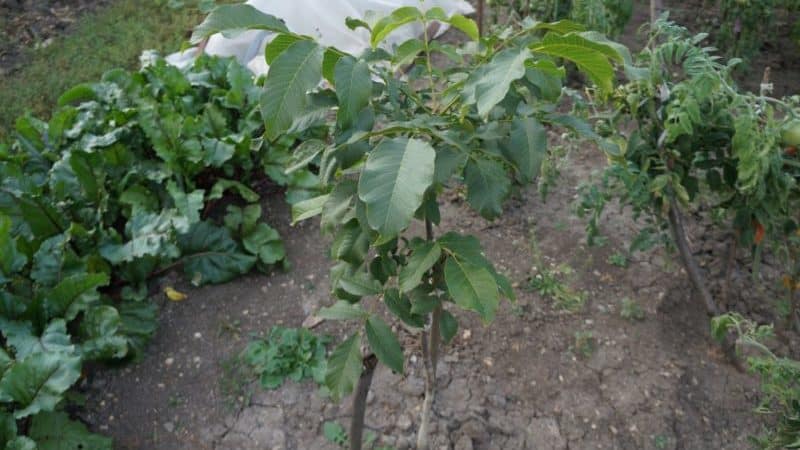
When sprouts appear from the nut or cuttings, the plant is transferred to a garden plot in open ground. To do this, prepare the growing site in advance.
Walnut does not tolerate cramped spaces and dense plantings, so a spacious and well-lit place is left for it. The soil should be sandy loam, loose and nutritious.Wet soils are not suitable - the plant will often get sick.
The distance between seedlings is left at least 5 m. Suitable neighbors nearby are berry bushes, greenery, flower beds. Summer residents do not recommend planting walnuts next to other fruit trees - apple trees, pears, plums, apricots (with the exception of other varieties of walnuts).
Attention! Walnuts are planted in spring or autumn (late April or mid-May, early October). There is no consensus on when to plant a plant on a site. Gardeners take into account climatic conditions in each case.
Step-by-step instruction
The planting pit for walnuts is prepared 1-2 months in advance. It is half filled with planting soil and 300 g of ash and 300 g of manure are added.
Further landing instructions look like this:
- Lay a dense film so that the root system grows to the sides, and not in depth.
- A wooden peg is placed nearby.
- The lateral roots are carefully straightened in different directions and sprinkled with loose soil.
- Tie the tree to a peg and water it abundantly with settled water.
- Lightly compact the soil around it, and leave a small earthen mound near the base.
Caring for walnuts in the garden
To obtain a rich harvest, a walnut tree needs regular care.
A young plant requires regular watering, an adult - pruning and treatment against insect pests and rodents.
How to care for a seedling after planting
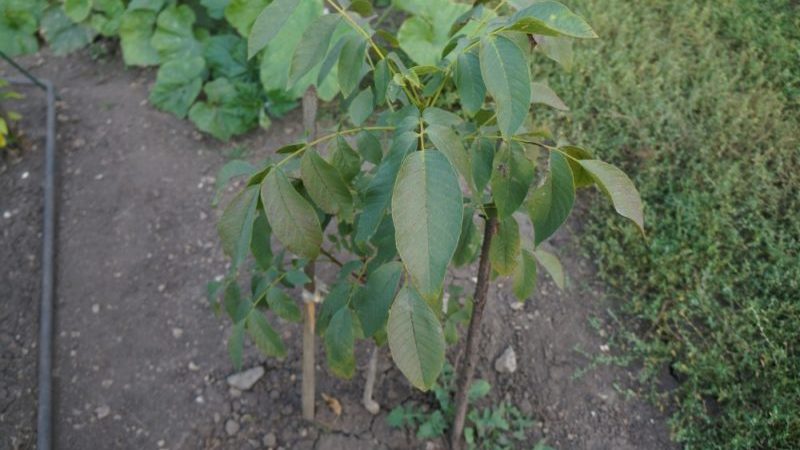
The plant loves moisture, so water it abundantly and often. On average, one tree uses 3 to 5 buckets of water. Before watering, the soil is loosened and cleared of debris, and small holes are made for water.
If organic and mineral fertilizers (ash, compost, vermicompost, superphosphate, complex fertilizers) were added to the hole when planting, the walnut is not fertilized in the next 2-3 years. An excess of organic matter and minerals is dangerous for a young plant: it will develop quickly, but the quality and quantity of the harvest will decrease by 2 times.
Attention! The nut experiences an increased need for moisture from late spring to mid-autumn. At this time, after watering, the plant is mulched with sawdust or leaves. Mulch retains moisture in the soil, which has a positive effect on tree development.
1 year after planting, the nut is cut off. The purpose of the procedure is to help the plant form the correct crown. Not only productivity, but also decorative appearance depends on this. In addition, insects appear more often in a thickened crown and diseases develop. When pruning, leave one main branch and pinch out the rest. Young green shoots are also removed.
Caring for an adult tree

After 3-4 years, the walnut is fertilized. At the beginning of summer, ammonium nitrate is added - per 1 sq. m around the plant takes about 6 kg of substance. At the end of June, organic fertilizers are used - they stimulate fruiting and strengthen the root system. This can be a solution of manure or peat - from 3 to 6 kg is used for one adult tree. If the tree is more than 20 years old, a mixture of 10 kg of superphosphate and 2 kg of potassium salt is used for fertilizer.
Gardeners have a popular fertilizer based on walnut leaves. Compost is prepared from them: the leaves are placed in a compost pit, watered with water and nitrogen fertilizer is added (30 g of nitrogen per 10 liters of water). Leave it for the winter, and in the spring mix it and moisten it again.
6-7 years after planting, the walnut tree is pruned.This is done annually, in early spring. Summer residents use garden shears and a saw (for thick shoots). During the rejuvenating procedure, all dry and damaged branches are removed. There will be no harvest for them, but they take away space and food. The cuts are made oblique and then treated with garden varnish to quickly restore the shoots.
Features of cultivation in different regions of Russia
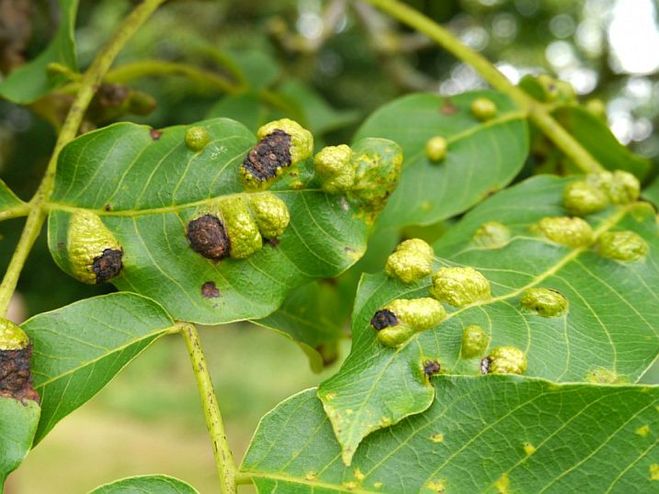
Nut care depends on the growing region. For example, summer residents of the Leningrad region pay special attention to loosening and weeding the land. Due to increased humidity, the root system rots. To prevent this, gardeners loosen the soil 3-5 times a season to a depth of 10 cm. And in the fall, after the leaves have fallen, the depth is increased to 20 cm. Also, once a week they clean the garden of weeds - a source of diseases and insect pests.
In the Moscow region and Krasnodar region, they ensure that only fruit-bearing and healthy branches are formed on the tree. The crown should be no more than 5 m in diameter, not thickened, each leaf should be well lit. Since trees enter the fruiting period late, this process can be accelerated by forming strong shoots 50 cm long, located in the crown at a distance of 50-70 cm from each other. This method of molding increases yield and allows the tree to ventilate.
In the Urals and Siberia, much attention is paid to protecting walnuts from diseases and pests. To prevent the appearance of brown spot, bacteriosis and root cancer, use a solution of caustic soda (100 g of substance per 10 liters of water). The plant is regularly inspected and the affected areas are removed. Insects include the walnut gall mite and the walnut aphid. They feed on leaf sap and inhibit the growth of young shoots.They get rid of them with the help of the drugs “Allethrin”, “Bartrin”, “Furethrin”.
Attention! Walnut cannot withstand temperatures below -28°C. Therefore, when planting, gardeners study the frost resistance of a particular variety and correlate it with the growing region.
Walnut flowering and fruiting
Walnut flowering begins in late April or early May, depending on the growing region. And fruiting occurs in September or October.
The weight of the walnut varies from 6 to 15 g, the shell is dark brown and durable. With proper care, a walnut tree bears fruit for up to 100-200 years.
When and how does it bloom
The flowers of the plant are unisexual and bloom simultaneously with the leaves. Pistillate and staminate inflorescences are located on the same tree. Staminates are dangling earrings of pale green color, and pistillate flowers are rounded flowers.
All walnut varieties are self-pollinating, i.e. pollen is transferred from the male flower to the female one. But it often happens that it gets lost and does not fall into the desired flower.
Therefore, gardeners recommend planting 2-3 varieties at once in one area for cross-pollination, for example, Ideal, Fernor, Izobilny, Dessert. When planting pollinator varieties, maintain a distance between trees of at least 5 m.
Read also:
Is it possible to eat almonds on a weight loss diet?
Why doesn't it bear fruit?
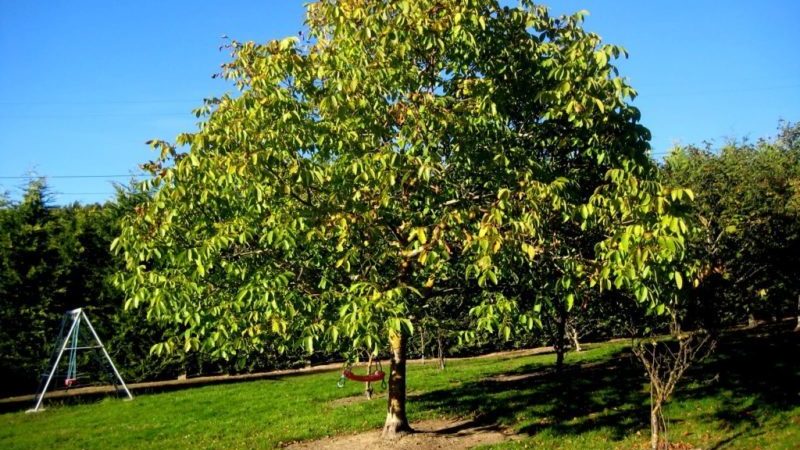
Problems with fruiting most often begin due to improper care. The tree produces a small harvest if it lacks moisture or fertilizer between April and September.In this case, there is no quick solution to the problem; you will have to wait until next spring and regularly water and fertilize the plant until autumn.
The reason for the lack of yield in young trees is severe thickening. Green branches and shoots grow in different directions and shade the entire tree. In this case, an integrated approach is required: the plant is pruned and shaped, then fertilized and mulched. It is also recommended to dig around the tree with a pitchfork to improve soil permeability.
Attention! Poor yield may indicate that the tree has been overfed. The walnut “fattens” when there is intense green growth, but there is no flowering. Gardeners stop watering and fertilizing the plant and add purified river sand to the soil.
Conclusion
The tree is grown from a nut or cuttings. In the first case, healthy fresh fruits are prepared, disinfected and soaked in water for several days. If cuttings are taken, inspect them for damage and signs of rot. The resulting seedling is placed on the site in spring or autumn, having previously prepared a planting hole.
Caring for a walnut tree consists of watering and fertilizing, loosening the soil and pruning. For a rich harvest, several varieties are planted in one area at once.